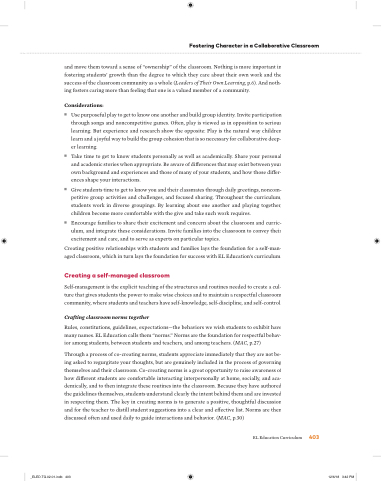Page 429 - EL Grade Teacher Guide - Module 1
P. 429
Fo ering Character in a Collaborative Classroom
and move them toward a sense of “ownership” of the classroom. Nothing is more important in fostering students’ growth than the degree to which they care about their own work and the success of the classroom community as a whole (Leaders of Their Own Learning, p.6). And noth- ing fosters caring more than feeling that one is a valued member of a community.
Considerations:
Use purposeful play to get to know one another and build group identity. Invite participation through songs and noncompetitive games. Often, play is viewed as in opposition to serious learning. But experience and research show the opposite: Play is the natural way children learn and a joyful way to build the group cohesion that is so necessary for collaborative deep- er learning.
Take time to get to know students personally as well as academically. Share your personal and academic stories when appropriate. Be aware of di erences that may exist between your own background and experiences and those of many of your students, and how those di er- ences shape your interactions.
Give students time to get to know you and their classmates through daily greetings, noncom- petitive group activities and challenges, and focused sharing. Throughout the curriculum, students work in diverse groupings. By learning about one another and playing together, children become more comfortable with the give and take such work requires.
Encourage families to share their excitement and concern about the classroom and curric- ulum, and integrate these considerations. Invite families into the classroom to convey their excitement and care, and to serve as experts on particular topics.
Creating positive relationships with students and families lays the foundation for a self-man- aged classroom, which in turn lays the foundation for success with EL Education’s curriculum.
Creating a self-managed classroom
Self-management is the explicit teaching of the structures and routines needed to create a cul- ture that gives students the power to make wise choices and to maintain a respectful classroom community, where students and teachers have self-knowledge, self-discipline, and self-control.
Crafting classroom norms together
Rules, constitutions, guidelines, expectations—the behaviors we wish students to exhibit have many names. EL Education calls them “norms.” Norms are the foundation for respectful behav- ior among students, between students and teachers, and among teachers. (MAC, p.27)
Through a process of co-creating norms, students appreciate immediately that they are not be- ing asked to regurgitate your thoughts, but are genuinely included in the process of governing themselves and their classroom. Co-creating norms is a great opportunity to raise awareness of how di erent students are comfortable interacting interpersonally at home, socially, and aca- demically, and to then integrate these routines into the classroom. Because they have authored the guidelines themselves, students understand clearly the intent behind them and are invested in respecting them. The key in creating norms is to generate a positive, thoughtful discussion and for the teacher to distill student suggestions into a clear and e ective list. Norms are then discussed often and used daily to guide interactions and behavior. (MAC, p.30)
EL Education Curriculum 403
_ELED.TG.02.01.indb 403
12/6/18 3:42 PM


